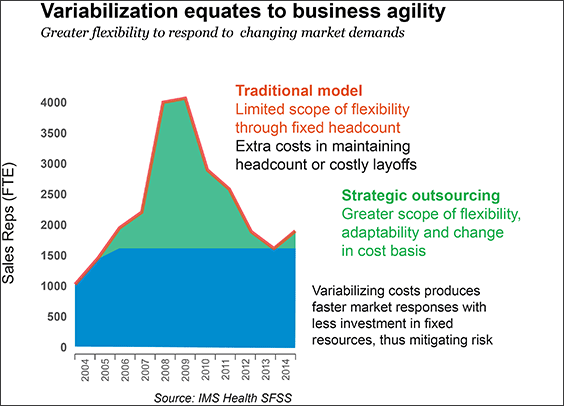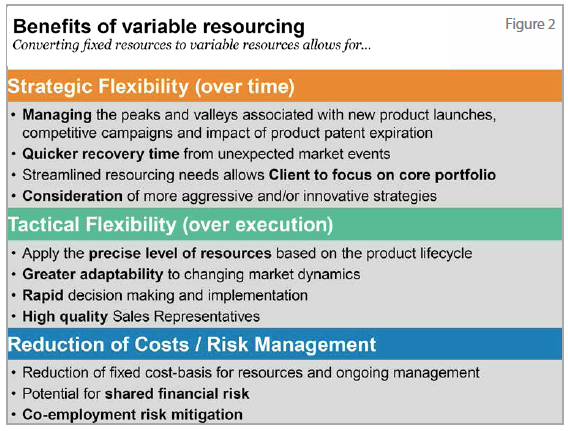Biopharmaceutical companies’ commercial paradigms must respond to an ever-changing marketplace, with increasing demands from both payers and patients for better care, improved outcomes, more affordable therapies, and increased speed to market. In a recent interview, George Esgro, Vice President & Head, U.S. Commercial Sales, Quintiles, discussed how strategic outsourcing can help companies deliver the necessary adaptability, flexibility and cost efficiencies.
payers and patients for better care, improved outcomes, more affordable therapies, and increased speed to market. In a recent interview, George Esgro, Vice President & Head, U.S. Commercial Sales, Quintiles, discussed how strategic outsourcing can help companies deliver the necessary adaptability, flexibility and cost efficiencies.
What Trends Do You Expect to See in Commercial Outsourcing in 2015?
In the coming year, outsourcing will respond to biopharma firms’ needs to maximize their promotional budgets, with resource allocations leaning toward newer launch opportunities and maximizing return on investment of mature brands.
Commercial pressures are driving a need for more products in the market to boost revenue streams, and increasing receptivity to clinical-commercial convergence, where commercial factors are taken into account at the earliest possible point in the clinical development process.
Companies must also respond to increasing complexities in the global regulatory pattern, the expanding focus on patient care, adherence and unmet needs. Negative impacts on commercial paradigms are being felt from factors such as reduced patent stability, lower spending on promotion and sales forces, newer competitors and new technologies, which further support traditional detailing by biopharma sales representatives.
According to The Future of Outsourcing by Datamonitor, companies can achieve added value by using sales force outsourcing strategically. Since variable costs can be adjusted more easily than fixed costs, companies can respond more quickly and efficiently to changes in circumstances without being constrained by investments that have been made in-house.
Why Take a Systematic Approach to Outsourcing?
An important principle to keep in mind is that outsourcing should be viewed as a business strategy — in the context of total portfolio optimization — rather than as a one-off approach, such as short term launch muscle. It should be viewed from the context of other business initiatives such as IT, business process reengineering, or major restructuring. To achieve maximum benefits from outsourcing, biopharma companies must adopt a systematic approach, setting targets as part of a three-to-five year strategic plan, with continuous measurement of progress.
What Are the Benefits of Strategic Outsourcing?
Strategic outsourcing offers many benefits for biopharma companies (Figure 1). These include strategic flexibility to respond to changing market dynamics, quicker recovery time from unexpected market events, relief of management attention and oversight burden, streamlined resourcing needs allowing a focus on the company’s core portfolio, and ability to adopt more innovative or aggressive strategies. At the tactical level, strategic outsourcing also allows rapid decision-making and implementation, giving companies the ability to apply a precise level of resources based on the stage of the product lifecycle and any changes in market conditions.
Key benefits of strategic outsourcing from the biopharma company perspective include:
Ability to change the business model from fixed to variable resourcing (variabilization)
Greater adaptability to react to changing market dynamics, for example, around product launches, loss of exclusivity, or competitive pressures
Increased flexibility managing promotional resources, including human, financial and operational resources, with the ability to change the cost basis of FTEs.
Access to expertise and best practices outside of the organization — including access to high quality sales representatives — providing potential competitive advantage.
Outsourcing can offer greater flexibility in managing promotional resources, human resources, financial and operational factors, and the ability to change the cost basis of current FTEs over time through a Strategic Vacancy Management approach.
What is the optimum talent profile for a product portfolio?
 The optimum profile for sales representatives varies through the product lifecycle from launch to loss of exclusivity (LOE). Outsourcing provides biopharma companies with the flexibility to adjust this profile, depending on the stage in the lifecycle and the portfolio needs; for example, many business have now started using varying profiles from less tenured to B2B reps depending on their specific needs during various lifecycle stages.
The optimum profile for sales representatives varies through the product lifecycle from launch to loss of exclusivity (LOE). Outsourcing provides biopharma companies with the flexibility to adjust this profile, depending on the stage in the lifecycle and the portfolio needs; for example, many business have now started using varying profiles from less tenured to B2B reps depending on their specific needs during various lifecycle stages.
Outsourcing may also offer a more systematic and consistent approach to recruitment, including web screening, behavioral insights, a phone assessment and in-person interview. This enables candidates with the ideal skill set and attitudinal profile to be identified for each specific need, and provides the flexibility to change these as necessary.

How Does Variabilization Work?
Transforming fixed assets and costs to variable ones offers an attractive alternative for many companies (Figure 2). Variabilization provides greater flexibility to respond to fluctuating resource demands by making value chains more elastic and cost efficient.
With this fundamental shift from fixed to variable costs comes the ability for senior leadership to effectively manage the peaks and valleys in product life cycles and allow their organizations to be more agile while also increasing cost efficiencies and potentially reducing their cost basis through decreasing the fully loaded costs of their FTEs.
One example of a variabilization approach is a strategic vacancy management program, where both long- and short-term vacancies are filled through an outsourced provider. This can increase launch “muscle" or use variable assets for mature or LOE brands.
Another example is the ability to change the mix of existing personal promotion models from a traditional, homogeneous structure to one that varies by geographical need.
The different FTE models — ranging from specialty representatives to a more basic, service-type representatives, to more complex credentialed healthcare providers — provide variable ways to promote brands through traditional “feature/benefit" messaging or through branded and non-branded education.
In summary, biopharmaceutical companies have now embraced the idea that planning for commercial organizations should involve the use of CSOs to offset risk, manage costs, and improve long-term success. They also have realized that thinking about non-traditional approaches to sales representative profiles can have a dramatic effect on costs as well as results, not only for mature products but also for launch brands. These approaches provide a natural fit for any biopharma company’s organization. (PV)
Quintiles (NYSE: Q), a Fortune 500 company, is the world’s largest provider of biopharmaceutical development and commercial outsourcing services. With a network of >32,000 employees conducting business in >100 countries, they helped develop or commercialize all of 2013’s Top 100 best-selling drugs on the market. Quintiles applies the breadth and depth of service offerings along with extensive therapeutic, scientific and analytics expertise to help customers navigate an increasingly complex healthcare environment.
For more information, visit quintiles.com


















